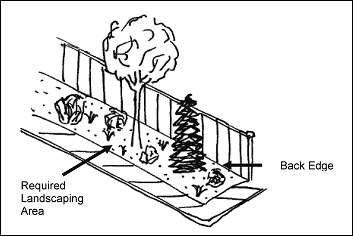22.46.030 Landscaping plans.
A. Landscaping Plan Design Criteria.
1. Preserve as much existing native vegetation as possible, with preference given to plant groupings. Fill in native vegetation with evergreen trees and shrubs in natural and random patterns where possible.
2. Provide areas on site for active and/or passive recreational purposes consistent with open space requirements in Chapter 22.42 MMC, Design Standards.
3. Provide separation between incompatible adjacent land uses or activities, and reduce the impact of wind, lighting, and noise and/or the perception of noise.
4. Design landscaping to accommodate changes in design between adjacent sites, within a site, and from native vegetation areas.
5. Design foundation plantings to create an effective change from public to private space and from the vertical to horizontal plane at building edges.
6. Design plantings to soften elevations, reduce the visual impact of less desirable development and/or structures such as large blank walls, retaining walls, dumpster areas, service areas, and large areas of pavement.
7. Use plantings to highlight significant site features and to define site use areas and circulation corridors without interfering with the use of such areas. Examples include site and building entrances, pedestrian walkways, gathering areas, and plazas.
8. Design landscaping to use plants and planting techniques that reduce water consumption.
9. Plants shall be selected and arranged according to the following design criteria:
a. Arrange plants in a composition that creates an overall unified and balanced design.
b. Select a variety of plants providing interest, accent and contrast, using as many native species as possible.
c. Select plants with an awareness of their growth requirements, tolerances, ultimate size, preferences for soil, climate and sun exposure, and negative impacts.
e. Develop a planting design compatible with, and conforming to, the overall project design concept and adjoining properties.
f. Provide plants of adequate size, in an appropriate quantity, and at a spacing, that fulfills the function and design objectives within the stipulated time.
10. Landscaping shall be installed on private property adjacent to rights-of-way. Where there is right-of-way between the back of sidewalk or curb and the property line, landscaping shall be installed in that area by the adjacent developer in a complementary manner to the on-site landscaping. Landscaping in the right-of-way shall not be used as part of minimum landscaping requirements or to meet perimeter landscaping requirements, except that trees planted in the right-of-way can be counted towards meeting tree requirements.
11. If subdivision fencing is proposed adjacent to a sidewalk, fences shall be constructed at the back edge of the required landscaping area or easement as depicted below.
Figure 22.46.030. Fences Shown at Back Edge of Required Landscaping Area or Easement

12. If private homeowner fences are proposed, fences shall be constructed at the back edge of the required landscaping area tract or easement.
13. All areas maintained in a pervious manner, which exceed the required landscape area, must be seeded or otherwise planted to reduce erosion and storm water runoff.
14. Landscaping shall accommodate and shall not interfere with infrastructure and below or above-ground utilities.
B. Landscaping Plan Approval.
1. A development application submittal shall include a preliminary landscaping plan in compliance with the provisions of this chapter. A final landscape plan that is consistent with the preliminary plan, and is consistent with that checklist and with the conditions of approval, shall be submitted and approved prior to project permit approval or building permit issuance.
2. Landscape plans for subdivisions, site plans, and other projects shall be prepared by a licensed landscape architect and stamped and signed by such professional.
3. As determined by the zoning administrator, the city may use a licensed landscape architect to perform peer review of submitted landscape plans. The costs of such review shall be paid by the developer. (Ord. 005/2019 § 10 (Exh. B))